AT-S82 Management Software User’s Guide
You can change the bridge priority number in the
The bridge priority has a range 0 to 61440 in increments of 4096. To make this easier for you, the
Table 3. Bridge Priority Value Increments
Increment | Bridge |
| Increment | Bridge |
Priority |
| Priority | ||
|
|
| ||
|
|
|
|
|
|
|
|
|
|
0 | 0 |
| 8 | 32768 |
|
|
|
|
|
1 | 4096 |
| 9 | 36864 |
|
|
|
|
|
2 | 8192 |
| 10 | 40960 |
|
|
|
|
|
3 | 12288 |
| 11 | 45056 |
|
|
|
|
|
4 | 16384 |
| 12 | 49152 |
|
|
|
|
|
5 | 20480 |
| 13 | 53248 |
|
|
|
|
|
6 | 24576 |
| 14 | 57344 |
|
|
|
|
|
7 | 28672 |
| 15 | 61440 |
|
|
|
|
|
Path Costs and Port Costs
After the root bridge has been selected, the bridges must determine if the network contains redundant paths and, if one is found, they must select a preferred path while placing the redundant paths in a backup or blocking state.
Where there is only one path between a bridge and the root bridge, the bridge is referred to as the designated bridge and the port through which the bridge is communicating with the root bridge is referred to as the root port.
If redundant paths exist, the bridges that are a part of the paths must determine which path will be the primary, active path, and which path(s) will be placed in the standby, blocking mode. This is accomplished by an determination of path costs. The path offering the lowest cost to the root bridge becomes the primary path and all other redundant paths are placed into blocking state.
Path cost is determined through an evaluation of port costs. Every port on
63
